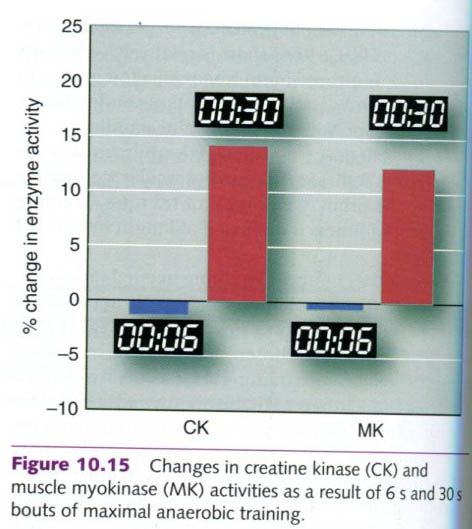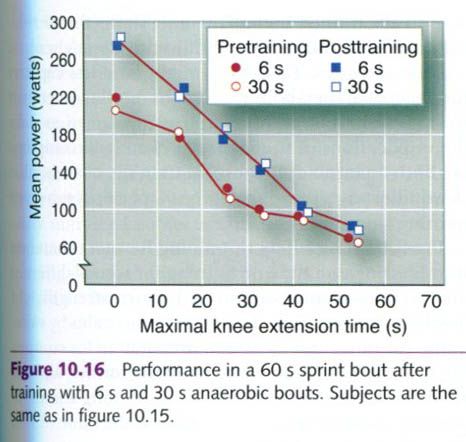Changes in anaerobic power and anaerobic capacity
Exercise scientists have had difficulty
agreeing on an appropriate laboratory or field test of anaerobic power. Unlike
the situation with aerobic power, for which VO2max is generally
agreed to be the gold standard measurement, no single test adequately measures
anaerobic power. Most research has been conducted through use of three
different tests of either or both anaerobic power and anaerobic capacity: the
Wingate anaerobic test, the critical power test, and the maximal accumulated oxygen deficit test. Of these three, the
Wingate test has been the most widely used.
With the Wingate anaerobic test, the subject
pedals a cycle ergometer at maximal speed for 30s against a high braking force.
The braking force is determined by the person’s weight, sex, age, and level of
training. Power output can be determined instantaneously throughtout the 30s
test but is generally averaged over 3 to 5s intervals. The peak power output is
the highest mechanical power achieved at any stage in the test; it is generally
achieved during the first 5 to 10s and is considered an index of anaerobic
power. The mean power output is computed as the average power output over the
total 30s period, and one obtains total work simply by multiplying the mean
power output by 30s. Mean power output and total work have both been used as
indexes of anaerobic capacity.
With anaerobic training, such as sprint
training on the track or on a cycle ergometer, there are increases in both peak
anaerobic power and anaerobic capacity. However, results have ranged widely
across studies, from those that showed only minimal increases to those
showing increases of up to 25%.
Adaptations in muscle with anaerobic training
With anaerobic training, which includes sprint
training and resistance training, there are changes in skeletal muscle that
specifically reflect muscle fiber
recruitment for these types of activities. At higher intensities, type II muscle fibers are recruited to a
greater extent, but not exclusively, because type I fibers continue to be recruited. Overall, sprint and
resistance activities use the type II muscle fibers significantly more than do aerobic activities. Consequently,
both type IIa and type IIx muscle fibers
undergo an increase in their cross-sectional areas. The cross-sectional area of
type I fibers also is increased but usually to a lesser extent. Furthermore,
with sprint training there appears to be a reduction in the percentage of type
I fibers and an increase in the percentage of type II fibers, with the greatest
change in type IIa fibers. In two of these studies, in which subjects performed
15s or 15s and 30s all-out sprints, the type I percentage decreased from 57% to
48% and type IIa increased from 32% to 38%. This shift of type I to type II fibers usually
is not seen with resistance training.
Adaptations in the energy systems
Just as aerobic training produces changes in
the aerobic energy system, anaerobic training alters the ATP-PCr and anaerobic
glycolytic energy systems. These changes are not as obvious or predictable as
those that result from endurance training, but they do improve performance in
anaerobic activities.
Adaptations
in the ATP-PCr system
Activities that emphasize maximal muscle force
production, such as sprinting and weightlifting events, rely most heavily on
the ATP-PCr system for energy.
Maximal effort lasting less than about 6s places the greatest demands on the
breakdown and resynthesis of ATP and PCr. Costill and coworkers reported their
findings from a study of resistance training and its effects on the ATP-PCr system. Their participants
trained by performing maximal knee extensions. One leg was trained using 6s
maximal work bouts that were repeated 10 times. This type of training preferentially
stressed the ATP-PCr energy system. The other leg was trained
with repeated 30s maximal bouts, which instead preferentially stressed the glycolitic system.
The two forms of training produced the same
muscular strength gains(14%) and the same resistance to fatique. As seen in the
figure below, the activities of the anaerobic muscle enzymes creatine kinase
and myokinase increased as a result of the 30s training bouts but were almost
unchanged in the leg trained with repeated 6s maximal efforts. This finding
leads us to conclude that maximal sprint bouts(6s) might improve muscular
strength but contribute little to the mechanisms responsible for ATP and PCr
breakdown. Data have been published, however, that show improvement in ATP-PCr
enzyme activities with training bouts lasting only 5s.
Regardless of the conflicting results, these
studies suggest that the major value of training bouts that last only a few
seconds(sprints) is the development of muscular strength. Such strength gains
enable the individual to perform a given task with less effort, which reduces
the risk of fatique. Whether these changes allow the muscle to perform more
anaerobic work remains unanswered, although a 60s sprint-fatique test suggests
that short sprint-type anaerobic training does not enhance anaerobic endurance.
Adaptations
in the glycolytic system
Anaerobic training(30s bouts) increases the
activites of several key glycolytic enzymes. The most frequently studied
glycolytic enzymes are phosphorylase, phosphofructokinase(PFK), and lactate
dehydrogenase. The activities of these three enzymes increased 10% to 25% with
repeated 30s training bouts but changed little with short(6s) bouts that stress
primarily the ATP-PCr system. In a
more recent study, 30s maximal all-out sprints significantly increased hexokinase(56%) and PFK(49%) but not total phosphorylase
activity or lactate dehydrogenase.
Because both PFK and phosphorylase are
essential to the anaerobic yield of ATP, such training might enhance glycolytic capacity and allow the muscle
to develop greater tension for a longer period of time. However, as seen in the
figure below, this conclusion is not supported by results of a 60s sprint
performance test, in which the subjects performed maximal knee extension and
flexion. Power output and the rate of
fatique(shown by a decrease in power production) were affected to the same
degree after sprint training with either 6 to 30s training bouts. Thus,
we must conclude that performance gains with these forms of training result from
improvements in strength rather than improvements in the anaerobic yield of
ATP.











0 коментара:
Постави коментар